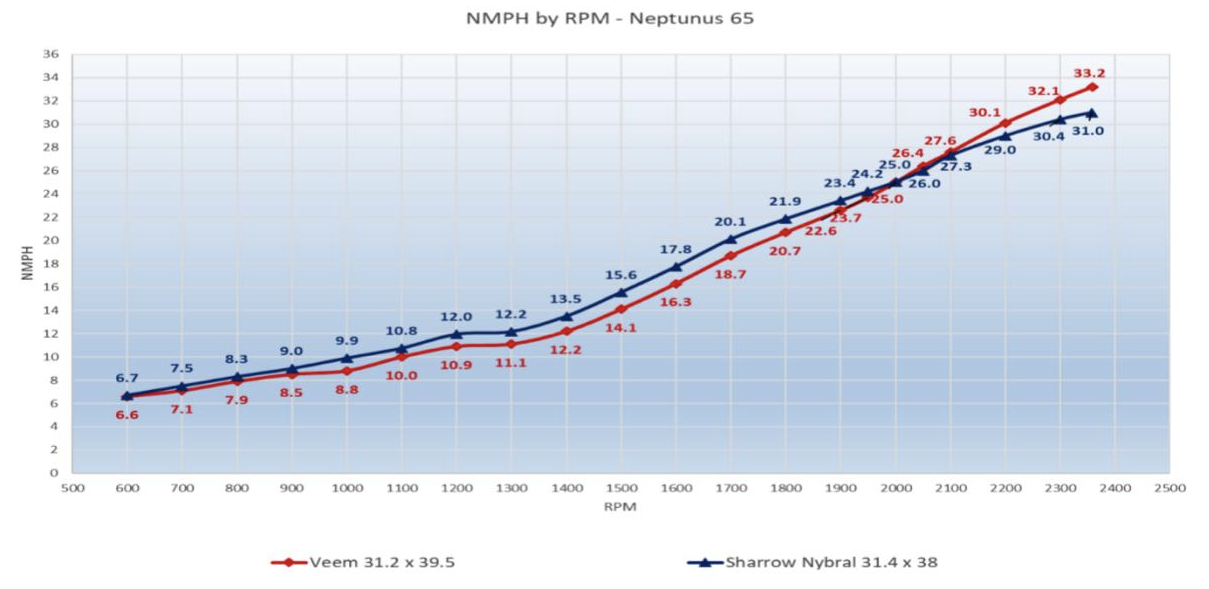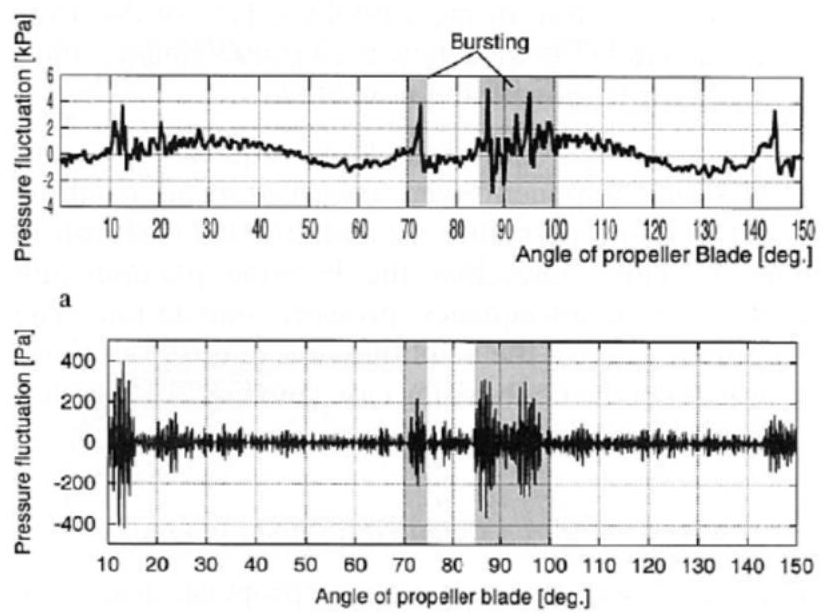Sharrow Props Tested on a Motoryacht
Over the last three years, BoatTEST has published a dozen reports on tests that we and Sharrow Marine have made on outboard-powered boats of all kinds — but never on a large, inboard diesel-powered motoryacht. Since the Sharrow prop's strong suit has always greatly enhanced fuel economy and performance at cruising speeds — motoryachts seem like a natural.
That's why this first test on a 78,000-lb. (35,454-kg) yacht is so important.
Neptunus Yachts
The Neptunus Yachts boat yard is located in St. Catharines, Ontario, Canada, and it has been building large semi-custom motoryachts for more than 30 years. The company builds two or three boats a year, all are between 55' and 75' (16.76 - 22.86 m) and the folks there work hard to provide high-quality yachts with state-of-the-art features. All of the yard's boats are built to CE Category "A" Ocean Certified Vessel standards.
Since it is a boutique builder, in order to compete with the big production-line motoryacht builders in Europe, the company ensures that each customer feels their personalized Neptunus is truly the best yacht they have ever owned. Little wonder then that Neptunus management has spent a lot of time experimenting with props to improve their boats' performance.

The Motoryacht
Virtually all motoryacht owners want to get the most economical operation possible out of their yachts. Boats of this size and weight can easily burn 75 or 100 gallons an hour. At $5 per gallon, that means they can burn through money faster than a hi-tech start-up. So, when it discovered Sharrow props, Neptunus management decided to try them and was the first motoryacht builder to do so, and be able to evaluate their impact on performance.
The Neptunus 650 has a 1,000 gal. (3,700 L) fuel capacity. So for a fill-up, it is pushing $5,000 in most marinas, if not more. Savings of, say, just 10%, means thousands of dollars over the lifetime of a vessel.
The test 65' (19.81 m) motoryacht has a 16'7" (5.05 m) beam and a dry weight of 78,000 lbs. (35,454 kg). Typically, in this model, Neptunus installs twin CAT C-18s that generate about 1,136 hp each.
The Sea Trials
This is by far the heaviest boat ever to try on a pair of custom-made Sharrow props — and it is the first boat with inboard diesel engines that have been tested by Sharrow. Sharrow techs, along with boatyard personnel, conducted comparison sea trials in the 650 on Lake Ontario. The charts and all of the data you see here were provided to BoatTEST by Sharrow Marine.
Conventional Veem Props
For this test, the Neptunus 650 was equipped with a pair of Veem 32.2 x 39.5 props. Veem is an Australian company that started making propellers in the 1990s for commercial, military and recreational boats. Veem's most notable innovation was the introduction of the plastic "Interceptor" on the surface of its blades whereby the props' pitch could be effectively changed by sliding into a groove plastic strips of different heights. Veem is generally regarded in the industry as one of the best prop manufacturers.
All Veem props are CNC machined to the tightest tolerances possible and because of that, this may be the toughest competition that Sharrow has ever faced.
But, as good as they are, Veem props are still a conventional design.

Revolutionary Sharrow Props
Sharrow props are revolutionary because they are the first new prop concept developed since the first propellers appeared in the 1830s. Sharrow NX™ inboard propellers are available directly from Sharrow to the boatbuilder, or the boat owner. It offers custom-designed and manufactured Nibral props for each specific application. Sharrow's special builder program offers props from 12" to 60" (0.3 m to 1.5 m) in diameter.
Sharrow techs work closely with boat builders to find out the specific needs of each boat. Then they crank a dozen or more variables through its proprietary software that has taken years and millions of dollars to develop — to create the optimum Sharrow prop geometry for every specific application. One size does not fit all, or even a few. Each Sharrow NX™ prop is unique.
The Comparison Test

As can be seen in the chart above, the Veem props were 31.2" x 39.5" and the Sharrow props were 31.4" x 38". The above chart records nautical miles per hour (knots) matched with RPM.
Our take on the numbers: Just as we saw on gas outboard engine props, the Sharrows have slightly more "grip" at idle speeds. This means quicker response when maneuvering the boat at the dock or in a crowded marina.
From 1000 to 1800 RPM, the normal cruising range for boats of this type, the vessel was from 8% to 12.5% faster. At 2000 RPM, the Veem prop ties the Sharrow in speed and goes on to have a WOT speed of 2.2 knots more.

A Big Savings at Best Cruise
Operating the boat at 12 knots (13.8 mph) with the Sharrow props, the boat gets .50 NMPG — 52% better than the Veem props at the same speed. This is the most economical cruising speed. At that speed, going 100 miles, the boat would consume 312.5 gallons (1,156 L) with the Veems and just 200 gallons (757 L) with the Sharrows. With fuel at $5 per gallon and a 1,000-nautical-mile delivery, we're looking at a savings of $5,625 with the Sharrow props for the trip.
Charter yacht deliveries. Perhaps a better example is the cost of bringing a large motoryacht from its winter charter location in the British Virgin Islands to Nantucket via Miami. That route is about 2,400 nautical miles. At 12 knots, the Neptunus 650 would burn at .50 nmpg about 4,800 gallons (18,170 L) of diesel fuel. With the Veem prop at the same speed, the engines would burn about 7,500 (28,390.58 L) gallons. That's a difference of 2,700 gallons x $5 = $13,500. But what if marina diesel fuel is $6.50 per gallon? Then the savings with Sharrow props is $17,550.
Historically, captains tried to run boats at from 60% to 80% load to avoid cylinder glazing or bore glazing, which reduced efficiency and performance. But with the new generations of large diesel engines with common-rail, new EMS software, improved fuel injection and advancements in lubrication, running recreational motoryacht diesels in mid and lower RPM ranges is no longer an issue. One builder of large motoryachts which are typically driven at 11 or 12 knots, if not slower, has told us that his owners have had no trouble with this issue the last 15 years and over 200 motoryachts built.
For owners of large motoryachts that alternate between the Caribbean and New England each year for their own pleasure or for the charter trade, just the savings on deliveries can be from $26,000 to $34,000 per year, depending on fuel prices and distance.
Other than best cruising speed, three other speeds come to mind that owner/operators of boats this size typically like to drive their boats, conditions permitting, and they are 18 knots, 20 knots and 22 knots. As seen in the chart above, the Neptunus is able to achieve those speeds at 500 to 1000 RPM less with the Sharrow props.
Cruising from 18 to 22 knots burns a lot more fuel with both props, but the Sharrows are still 9% to 11% more fuel efficient. (See chart above.)

Operators of large boats generally think in terms of "gallons per hour" when considering fuel consumption, not miles per gallon. Big boats with huge diesel engines have a voracious appetite for fuel and using gallons per hour at a constant speed makes fuel management an easy mental exercise. A 10-hour day at 12 knots would save from $700 to $1,000 per day on a delivery, depending on the price of fuel with the Sharrow props vs. the Veems. (The Veems are already one of the most fuel-efficient standard design props on the market. The savings would be even greater with other make props.)
The Sweet Spot
Starting at idle we see that the boat gets the same GPH with both props until 10 knots. There, the Sharrow props break away getting 14 GPH compared to 19 GPH for the Veem props. Here, the Veems burn 36% more fuel per hour than the Sharrow props.
But it is at 12 knots where we see the greatest dichotomy between the two different designs.
The CAT C-18s need to burn 58% more fuel to achieve 12 knots with the Veem props.
As we follow the fuel burn up the range to higher speeds, we see that the boat can go from .5 to 2 knots faster with about the same fuel burn until we get to 24 knots. There the Veem props come into their own.
Details Not Tested

There are other aspects of props boaters find desirable in addition to fuel savings. For example, backing down. These tests are hard to measure and not conducted in this case. Nevertheless, Sharrow props clearly grip the water better than any other conventional prop on the market because of their patented design.
Cavitation is another problem that occurs with all conventional props because of the blade tip vortices. The Sharrow prop was designed specifically to eliminate blade tip vortices and therefore virtually eliminate that type of cavitation. No other prop maker can make that claim.


Noise is another aspect of inboard props that Sharrow props mitigate because of their patented design. The air bubbles in tip vortexes when they reach the surface of the water burst. Hard as it is to believe, the bursting of thousands of bubbles adds to the noise powerboats make — even though it can’t be distinguished from engine noise. Sharrow props virtually eliminate tip vortices bubbles, and noise is reduced.
Much more identifiable is prop vibration. Conventional props when made with five or more blades typically reduce vibration on inboard straight-shaft or V-Drive boats. Because of Sharrow's "loop prop" design, its three-blade props actually have six blades and its four-blade ones have eight blades. Reduced vibration is one of the first things people often notice on boats propped with Sharrow props.